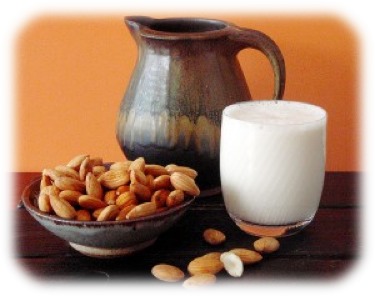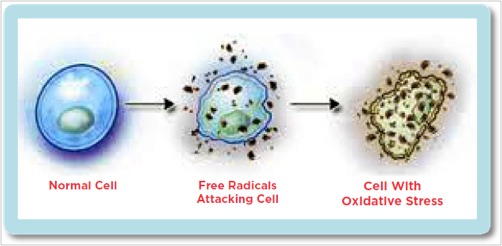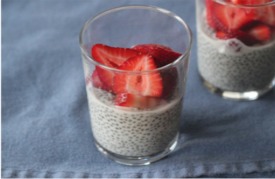News and Notes from The Johnson Center
Almond Milk Does a Body Better
JCCHD | Tue, October 01, 2013 | [Family and Food]
Almond milk is a great alternative to cow’s milk. It lacks cholesterol, lactose, and casein, which are all found in cow’s-milk products. These macronutrients are known to cause health problems for some people. High levels of cholesterol may lead to heart disease. (Regarding heart disease, what almond milk contains is just as important as what it doesn’t—the vitamin E found in almonds helps maintain and repair the lining of arteries.) [6] Lactose can cause discomfort if not digested properly. Casein, a protein found in milk, can also cause issues. Some scientists hypothesize that people with autism cannot break it down, with the result that the casein eventually makes its way to the bloodstream, possibly resulting in neurobehavioral problems. [7]
Vitamin D and Oxidative Stress
Almond milk is a good source of vitamin D and calcium.1 Vitamin D and calcium are important nutrients for children with autism. Research suggests that, on average, autistic children get only 25% of the recommended daily intake of vitamin D and 75% of calcium. [2] Calcium is important for muscle function and healthy bones. Deficiency causes cramps, spasm, hypertension, and insomnia. [3] Vitamin D is essential because it reduces oxidative stress in the body. [2]
One way to measure oxidative stress is to analyze detoxifying agents such as glutathione. Glutathione plays an important role in animal cells: it acts as an antioxidant (eliminating free radicals), breaks down nutrients, and regulates cellular events like gene expression. [4] Low levels of glutathione are associated with cell damage, diabetes, cancer, and AIDS, and neurodegenerative and liver disease. [5] Alterations in concentration are also evident among children with autism. Vitamin D is shown to increase glutathione levels. [3]

How to Make Almond Milk
Almond milk has been around since the Middle Ages. It was preferred to cow’s milk because it did not spoil quickly. With modern technological advances, making almond milk is easy.
To make creamy almond milk, you need 1 part raw almonds and 4 parts filtered water. Almonds need to be soaked overnight before blending. Do not peel the almonds. Place the soaked almonds in a blender and add the water one cup at a time. Blend on high for 1-2 minutes. Once blended, remove the solids by pouring the liquid through a strainer, nut bag, or cheesecloth. Use almond milk as a substitute for cow’s milk in any recipe.
The solids can be dehydrated and used in gluten-free baked goods or breading for meat. Removing the moisture is simple. Thinly spread the solids onto a baking pan lined with a baking sheet and heat at 200°F. Time will vary from 3 – 5 hours, so check the status every two hours.
Here are a few recipes to help you get started.
Gluten-Free Cranberry Orange Oat Flour Pancakes
From http://www.theroastedroot.net

Ingredients
• 1 egg
• 1 cup almond milk
• 1 Tbl grapeseed oil (or oil of choice)
• 2 Tbl orange juice
• Zest of 1 orange
• ¼ tsp vanilla extract
• 1 cup oat flour
• 1 tsp baking powder
• ⅓ cup dried cranberries, blanched
• ⅛ tsp salt
Directions
1. Heat water in a tea kettle until boiling.
2. Put the dried cranberries in a small bowl and pour boiling water on top of them. Allow them to sit for 10 minutes until softened and puffy.
3. Strain the water from the cranberries and set cranberries aside.
4. In a mixing bowl, lightly beat the egg and add the almond milk, grapeseed oil, orange juice, orange zest and vanilla extract. Stir until combined.
5. Add the oat flour, salt and baking powder to the wet mixture and mix just until combined. Careful not to over-mix as over-mixing oat flour can make the pancakes very dense.
6. Add the blanched cranberries and mix.
7. Heat a large non-stick skillet just above medium heat. Add a couple teaspoons of oil to the skillet.
8. Measure ¼ cup of the pancake batter and pour it into the skillet.
9. Cook until edges firm up, about 2 minutes, then flip to the other side. Cook until golden brown on each side.
10. Repeat with all of the batter.
11. Serve with honey.
Chia Pudding
From http://www.eatingleanrecipes.com

Ingredients
• 1 ¼ cups almond milk
• ½ cup canned coconut milk
• ½ teaspoon pure vanilla
• Pinch fine sea salt
• ¼ cup chia seeds
Directions
1. In a large bowl whisk together almond milk, coconut milk, vanilla, and salt.
2. Add chia seeds; whisk to combine. Let stand at room temperature for 20 minutes, whisking occasionally to distribute chia seeds.
3. Once the chia seeds have absorbed the liquid and the mixture has thickened the chia pudding is ready to eat. Add desired toppings before serving.
Article Resources
1 http://nutritiondata.self.com/facts/custom/278488/2
2 http://www.omicsonline.org//2161-0509/2161-0509-2-115.digital//2161-0509-2-115.html
3 http://www.organicfacts.net/health-benefits/minerals/health-benefits-of-calcium.html
4 http://www.ncbi.nlm.nih.gov/pubmed/14988435
5 http://www.ncbi.nlm.nih.gov/pubmed/18158646
6 http://www.mayoclinic.com/health/nuts/HB00085
7 http://www.healthychildren.org/English/healthy-living/nutrition/pages/Gluten-Free-Casein-Free-Diets.aspx?nfstatus=401&nftoken=00000000-0000-0000-0000-000000000000&nfstatusdescription=ERROR%3a+No+local+token



